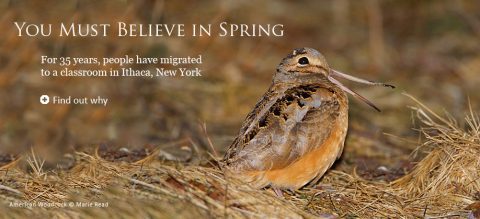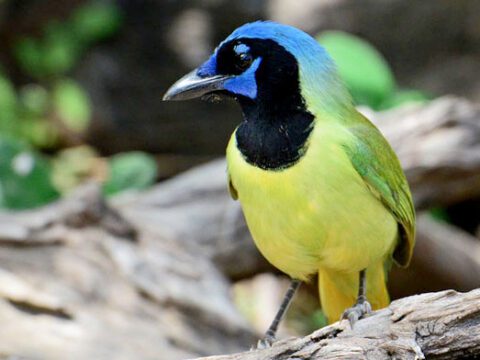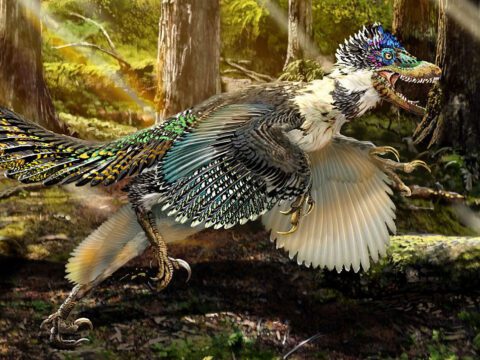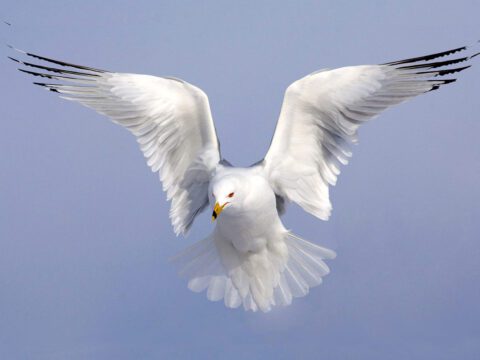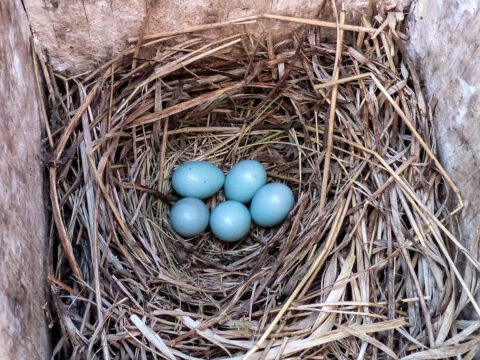Half a Century and Counting: the 50th Anniversary of Living Bird
By Tim Gallagher
January 15, 2012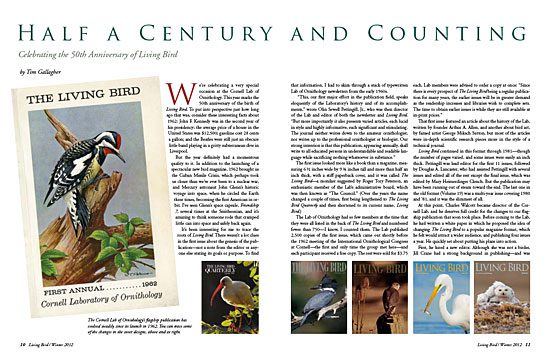
We’re celebrating a very special occasion at the Cornell Lab of Ornithology. This year marks the 50th anniversary of the birth of Living Bird. To put into perspective just how long ago that was, consider these interesting facts about 1962: John F. Kennedy was in the second year of his presidency; the average price of a house in the United States was $12,500; gasoline cost 28 cents a gallon; and the Beatles were still just an obscure little band playing in a gritty subterranean dive in Liverpool.
But the year definitely had a momentous quality to it. In addition to the launching of a spectacular new bird magazine, 1962 brought us the Cuban Missile Crisis, which perhaps took us closer than we’ve ever been to a nuclear war, and Mercury astronaut John Glenn’s historic voyage into space, when he circled the Earth three times, becoming the first American in orbit. I’ve seen Glenn’s space capsule,Friendship 7, several times at the Smithsonian, and it’s amazing to think someone rode that cramped little can into space and safely back again.
It’s been interesting for me to trace the roots of Living Bird. There weren’t a lot clues in the first issue about the genesis of the publication— not a note from the editor or anyone else stating its goals or purpose. To find that information, I had to skim through a stack of typewritten Lab of Ornithology newsletters from the early 1960s.
“This, our first major effort in the publication field, speaks eloquently of the Laboratory’s history and of its accomplishments,” wrote Olin Sewell Pettingill, Jr., who was then director of the Lab and editor of both the newsletter and Living Bird. “But more importantly it also presents varied articles, each lucid in style and highly informative, each significant and stimulating. The journal neither writes down to the amateur ornithologist, nor writes up to the professional ornithologist or biologist. Our strong intention is that this publication, appearing annually, shall write to all educated persons in understandable and readable language while sacrificing nothing whatsoever in substance.”
The first issue looked more like a book than a magazine, measuring 6 1/2 inches wide by 9 3/4 inches tall and more than half an inch thick, with a stiff paperback cover, and it was called The Living Bird—a moniker suggested by Roger Tory Peterson, an enthusiastic member of the Lab’s administrative board, which was then known as “The Council.” (Over the years the name changed a couple of times, first being lengthened to The Living Bird Quarterly and then shortened to its current name, Living Bird.)
The Lab of Ornithology had so few members at the time that they were all listed in the back of The Living Bird and numbered fewer than 750—I know, I counted them. The Lab published 2,500 copies of the first issue, which came out shortly before the 1962 meeting of the International Ornithological Congress at Cornell—the first and only time the group met here—and each participant received a free copy. The rest were sold for $3.75 each. Lab members were advised to order a copy at once: “Since there is every prospect of The Living Bird being a regular publication for many years, the earlier issues will be in greater demand as the readership increases and libraries wish to complete sets. The time to obtain earlier issues is while they are still available at in-print prices.”
That first issue featured an article about the history of the Lab, written by founder Arthur A. Allen, and another about bird art, by famed artist George Miksch Sutton, but most of the articles were in-depth scientific research pieces more in the style of a technical journal.
Living Bird continued in this format through 1981—though the number of pages varied, and some issues were easily an inch thick. Pettingill was lead editor for the first 11 issues, followed by Douglas A. Lancaster, who had assisted Pettingill with several issues and edited all of the rest except the final issue, which was edited by Mary Heimerdinger Clench. But the publication may have been running out of steam toward the end. The last one in the old format (Volume 19) was a multi-year issue covering 1980 and ’81, and it was the slimmest of all.
At this point, Charles Walcott became director of the Cornell Lab, and he deserves full credit for the changes to our flagship publication that soon took place. Before coming to the Lab, he had written a white paper in which he proposed the idea of changing The Living Bird to a popular magazine format, which he felt would attract a wider audience, and publishing four issues a year. He quickly set about putting his plans into action.
First, he hired a new editor. Although she was not a birder, Jill Crane had a strong background in publishing—and was fortunate enough to have the last name of a bird. Jill was a skilled writer who sometimes wrote short pieces for The New Yorker. She brought wit and creativity to the publication and also gathered together a team of first-rate writers—including Rick Bonney, who became a columnist and contributing editor and still works at the Cornell Lab, now as director of Program Development and Evaluation. It was during Jill’s tenure that people began referring to The Living Bird Quarterly as the “New Yorker of bird magazines.”
One of the key things Jill did was to reach out to others in the nature magazine field. She found a mentor in Les Line— legendary editor of Audubon magazine from 1966 to 1991, when it was arguably the best publication of its kind in the world. Jill often sent copies of the layouts from The Living Bird Quarterly to Les, and he obligingly marked them up with comments and suggestions. He was listed for several years on the masthead as “Consulting Editor.”
Linda G. Hooper designed the first four issues in the new format, followed by one issue designed by Richard Nadeau. And then Jill enlisted the services of Kat Dalton, a local freelance designer, to produce the Winter 1984 issue of the magazine, and she has been the design director of Living Bird ever since. Kat has always had a remarkable knack for telling a story with photographs and illustrations. She completed a major redesign of the magazine with her second issue, and right away began establishing a distinctive look for Living Bird, highlighting the beauty and elegance of the birds and the spectacular landscapes they inhabit.
After eight years as editor-in-chief of Living Bird, Jill Crane decided to hand over the reins to someone else, so she could spend more time working on her writing career, but she stayed on as associate editor for two more issues to help smooth the transition.
I was the person who took up the challenge of running Living Bird. At the time, I was a freelance writer and wildlife photographer based in California, but I had a lifelong interest in birds and a longtime background in publishing. I had previously worked at a daily newspaper and a monthly outdoors magazine—and had also been on the startup crew of WildBird in the mid-1980s, helping guide it from the concept stage all the way to becoming a thriving, popular magazine. In September 1990, I loaded everything I owned into my pickup truck and, like Jed Clampett of old, headed out across the nation to start a new life—but unlike Jed, I was headed to the frozen Northeast instead of the balmy climes of Beverly Hills. It changed my life. I soon married and began raising a family.
That was 21 years ago, and I’ve been working happily at the Cornell Lab ever since. Although the journal Pettingill and the others launched in 1962 bears little resemblance to the Living Bird of 2012, the spirit of what they were trying to accomplish still burns bright here 50 years later. I hope it will still be around half a century from today.

All About Birds
is a free resource
Available for everyone,
funded by donors like you
American Kestrel by Blair Dudeck / Macaulay Library
